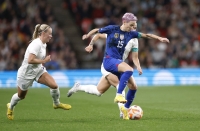Early projections show that this year's Women's World Cup could reach 2 billion viewers, nearly double the 1.12 billion who watched the 2019 edition, and participating athletes saw a surge of interest ahead of Thursday’s kickoff.
On Instagram, Swiss star Alisha Lehmann has watched her follower count hit 13.4 million, up 75% over the last year. That following is worth real money. According to ratings agency Nielsen Sports, a single Instagram post by Lehmann is worth $307,000 in media value to a sponsor.
Lehmann isn't an outlier.
Women's sports are growing in popularity and value. Better yet, that growth is no longer dependent upon quadrennial events like the Olympics or World Cups (though, as this year's tournament will likely prove, they certainly help). Investors, who've long been on the sidelines of women's sports, shouldn't wait to cash in. Though female athletes haven’t yet reached the heights of men — top male World Cup stars have far larger Instagram followings and media value — the growth potential is greater for them than it is for their male counterparts.
For example, in the U.S., the value of women's professional soccer franchises has increased more than tenfold in recent years.
In Los Angeles, the Angel City FC ownership group paid a $2 million fee to join the National Women's Soccer League in 2020; in April, a group led by private equity firm Sixth Street committed to a record $53 million expansion fee to place a NWSL team in San Francisco.
This should be a welcome sign to more investors, but they will have to confront some issues. Among other difficulties, men's team sports are well established as media properties and enjoy prime television viewing slots — such as Saturday and Sunday afternoons in the autumn for college and professional football — that women's sports can't hope to challenge (for now). Even leagues with followings and TV deals — such as the Women’s National Basketball Association (WNBA) — have had inconsistent schedules that make it difficult to become appointment viewing a la Monday Night Football. That's finally changing with a regular Friday night game for the WNBA this season.
The barrier extends beyond live broadcasts of games. In 2019, only 5.4% of televised sports news and highlights were devoted to women's sports. For years, these informal blackouts froze women's sports into niche events.
Yet over the last half-decade, a confluence of factors has begun to shift this gendered field. First, a younger generation of sports fans is embracing the social activism that comes along with women’s sports.
"Women's sport inherently stands for something, such as #MeToo, gender equality," explains Kirsten Sibbit-Johnston, an associate director at the London-based Sports Consultancy, where she works with sports rights holders and investors. "The current success of women's soccer in the U.S. stems from the players being such great advocates and fighting for something, making a stand."
Second, thanks to the growth of streaming, online highlights and social media, women's sports have become more accessible than ever, driving growth in fandom — and activism. A social media user who followed Megan Rapinoe for her LGBTQ advocacy might decide to pay attention to her goal-scoring capabilities this month, too (before she retires at the end of the year).
That's good for the business of women's sports.
In 2021, one survey found that 50% of women’s sports fans ”strongly agree” that sponsors should seek ”to make the world a better place.” Just 20% of fans of men’s sports expressed the same sentiment. That commitment — especially to gender equity — drives media rights and other deals. For example, in 2022, sponsorships for women's sports grew 20% year-over-year worldwide.
This year, in perhaps the most notable deal, Ally Financial Inc. made a multimillion-dollar ad buy across ESPN properties that will send 90% of the money to women's sports.
It's not charity. Justin Nicolette, director of public relations for Ally’s sports and entertainment division, recently explained the buy to Fast Company, saying, "People are so driven to support the brands that are supporting women’s sports."
The numbers don’t lie. Viewership for the 2022 WNBA playoffs was up 22% over 2021; this year, the NCAA Women's Final Four averaged 4.5 million television viewers, a 32% increase over 2022. Last summer, an exhibition between the U.S. and English women's soccer teams sold out in a day, drawing 78,000 fans to Wembley Stadium.
Inevitably, greater fan numbers and engagement are driving up the value of women's sports leagues and franchises. In February, the WNBA’s Seattle Storm sold a 14% stake in the team at a $151 million valuation — more than 10 times the prior record for a WNBA team. It's not just U.S. sports, either: In India, five new women's cricket franchises were recently sold at auction for a combined $572.4 million.
For now, major men's sports are worth more. National Football League, National Basketball Association and English Premier League franchises currently sell for billions. But despite impressive growth over the decades, NBA franchises aren't going to grow tenfold over the next five years, or 50. Women's sports are already doing it. This year’s Women’s World Cup is a reminder of just how culturally relevant and lucrative they have become. For investors keen to get a piece of the global sports market, the best opportunity is now in front of them.



















With your current subscription plan you can comment on stories. However, before writing your first comment, please create a display name in the Profile section of your subscriber account page.